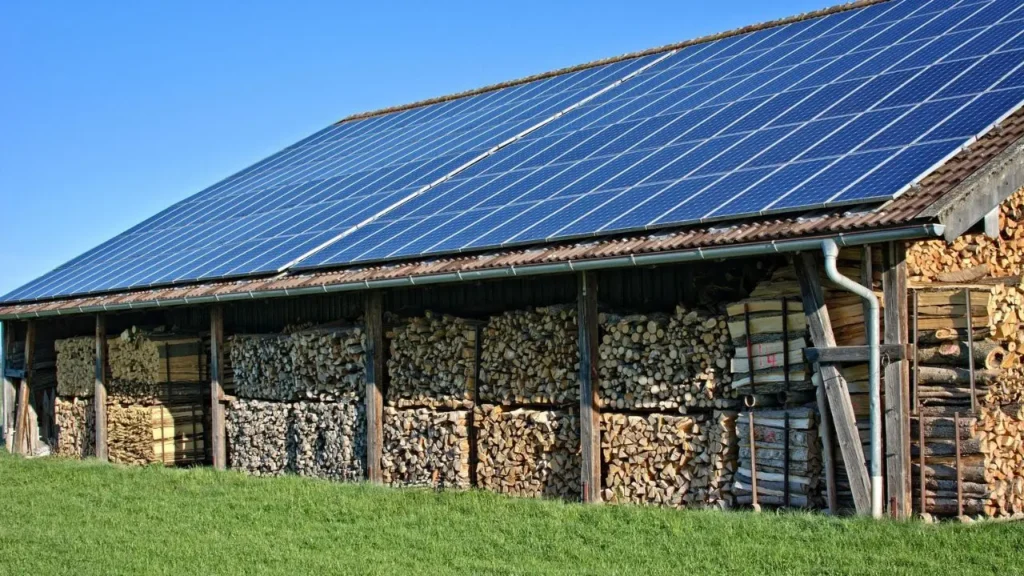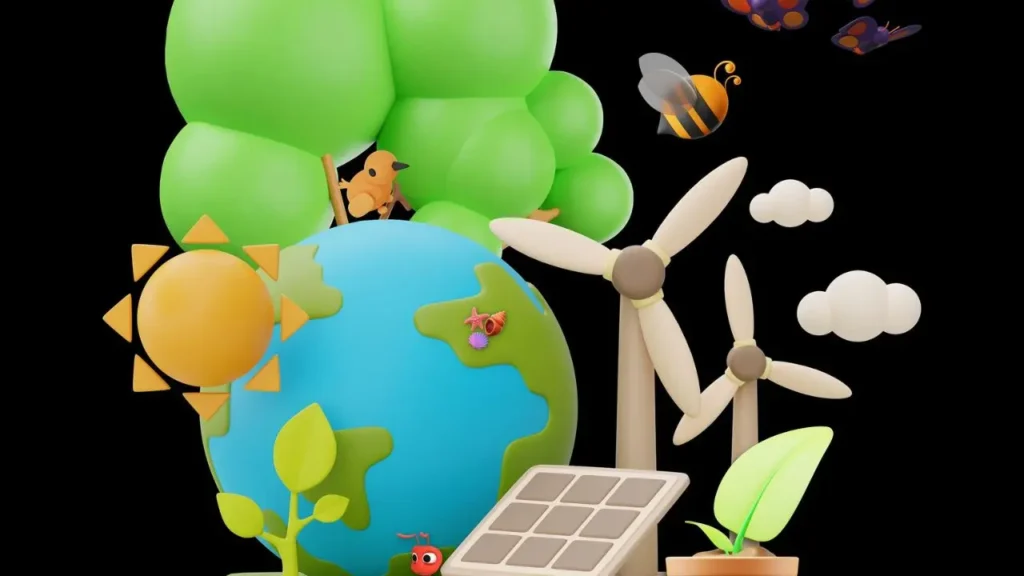
Introduction
Renewable energies are energy from natural sources which are renewed at a rate higher than their consumption.
Thus, an energy is said to be renewable when it is produced by a source that nature constantly renews, unlike an energy dependent on sources that are depleted.
Renewable energy is generally clean, meaning that it produces no or very few polluting emissions and thus contributes to the reduction of greenhouse gases in the atmosphere.
There are several types of renewable energy, produced from different sources, which can be presented as follows :
I : SOLAR ENERGY
Solar energy comes directly from the capture of solar radiation. It is the most abundant of all energy resources and can even be harnessed on cloudy days. It is an intermittent energy source that depends on sunlight.
It is produced in three forms :
1- Photovoltaic solar energy
Which creates energy through photovoltaic solar installations, they correspond to panels formed from semiconductor cells which directly transform light into electricity;
2- Solar thermal energy
Which creates energy via thermal collectors that use solar heat to heat water or buildings (solar water heater, heating, solar thermal panels);
3-Thermodynamic solar energy
Which uses optical concentration (using mirrors) and concentrated heat from solar radiation to produce electricity in a power plant.
Solar power is becoming increasingly accessible thanks to falling production costs and technological advances. Its advantage also lies in its ability to produce both heat and electricity, depending on the technology used.
II : WIND ENERGY
Wind energy harnesses the kinetic energy of the wind into electrical current using large wind turbines. There are two types of renewable wind energies depending on their installation areas :
1- Onshore wind turbines
Called onshore they are technically simple to install. In principle, a wind turbine starts producing at 15 km/h of wind and turns at full speed at around 40-50 km/h of wind;
2- Offshore wind turbines
Also known as offshore wind turbines, can be installed on the seabed (fixed wind turbines) or on a floating base (floating wind turbines). Offshore wind turbines have a higher efficiency than their land-based counterparts and are characterized by being more efficient in terms of energy production because the wind at sea is stronger and more constant than on land.
It should be noted that the technologies used have evolved over the last few years in order to maximize the electricity produced, thanks to taller turbines and larger diameter rotors.
III : GEOTHERMAL ENERGY
Geothermal energy involves harnessing accessible thermal energy from the Earth’s interior, which is the heat from underground aquifers, or even dry rocks, captured at varying depths. Geothermal power plants use underground reservoirs of steam and hot water called “hydrothermal reservoirs.” Heat is extracted through wells using two types of technology:
1- Shallow geothermal energy
Between 5 and 10 meters, uses the heat pump concept to produce heating;
2- Deep geothermal energy
Which seeks heat much further away. The average temperature of the Earth’s crust increases with depth, on average by 3°C every 100 m.
These geothermal power plants transform the extracted heat into steam to turn a turbine, which activates an alternator that generates an electric current.
It should be noted that geothermal energy is one of the only renewable energies, along with biomass energy, which is not intermittent and therefore does not depend on weather conditions.
IV : HYDRAULIC ENERGY
Hydropower harnesses the kinetic energy of water by using the force of moving water, such as dams, rivers, and waterfalls, to generate electricity. Two types of technologies are used :
1- Reservoir hydroelectric power plants
Use water stored in a reservoir and once released, the water passes through turbines which convert the kinetic energy into mechanical energy and then into electricity
2- Run-of-river hydroelectric power plants
Harness the energy from the available flow of the river.
The water’s movement drives turbines, which produce energy. The higher the water pressure, the greater the energy production. Moreover, the water cycle ensures the annual renewal of the resource. The volume of gross production varies depending on the level of rainfall.
It should be noted that the reservoirs of hydroelectric power plants serve several purposes :
- Provide drinking water and water for irrigation;
- Control floods and droughts;
- Provide navigation services and energy supply.
Marine renewable energies is part of hydraulic energy.

V : MARINE ENERGY
Marine energy is a type of hydropower that comes from technologies that use the kinetic and thermal energy of seawater (waves, currents) to produce electricity or heat.
Furthermore, we can distinguish two types of marine renewable energies :
1- Tidal energy
Which consists of exploiting the energy from the tides in coastal areas with high tidal range, where there is a significant difference in height between the water at high tide and low tide. Thus, the tidal power station installed in the dam separating the two basins makes it possible to produce electricity.
2- Osmotic energy
is based on the chemical phenomenon of osmosis which occurs when fresh water from rivers meets salty sea water. It should be noted that this technique is still at an early stage of development.
VI : BIOMASS
Biomass, also known as bioenergy, is the oldest form of energy used by humans. This resource allows electricity to be generated using the heat released through one of three main methods: combustion, gasification, and fermentation of products and materials of biological origin.
There are three categories of biomass, which take three different forms: wood (solid), biogas (gaseous), and biofuels (liquid).
Furthermore, we distinguish two types of biomass :
1- Traditional biomass
Mainly used in rural areas for cooking, lighting and space heating and generally by poor populations in developing countries.
2- Modern biomass
In particular from biofuels derived from plantations and biogas from the fermentation of household and agricultural waste, the three main production methods of which are :
– Methanization :
Corresponds to the degradation of organic matter, in particular agricultural waste, agri-food waste, bio-waste, etc.;
– Pyrogasification :
Is the process that produces methane from organic matter;
– Power-to-gas :
Allows electricity from renewable energies to be transformed into gas (methane), thus providing a solution for storing electricity.
Biogas is the renewable alternative to natural gas.
VII : NECLAIRE
Nuclear power is a carbon-free energy source because it does not emit greenhouse gases into the atmosphere. However, nuclear power is not considered a renewable energy source, as it relies on a limited raw material, uranium. used as fuel in nuclear reactors.
Thus, nuclear energy is considered to be a clean but non-renewable energy.
VIII : GREEN HYDROGEN
Hydrogen is a gas that can be used as a source of electrical energy. It is a gas that is rarely found in nature and is rarely renewed.
So, as such, hydrogen is not a renewable resource strictly speaking.
However, it is referred to as renewable or green hydrogen when it is produced from an abundant or renewable source such as water.
Conclusion
Renewable energies play a predominant role in there energy transition. They help reduce dependence on fossil fuels, which are considered non-renewable, as their stock is limited and continuously decreasing.
It is therefore essential to promote their development to combat the global warming.

Если требуется автоматизированная работа, можно база форумов для хрумера скачать и протестировать ее.
Hello !!
I came across a 137 very cool resource that I think you should browse.
This platform is packed with a lot of useful information that you might find interesting.
It has everything you could possibly need, so be sure to give it a visit!
https://snapsource.net/the-essential-tips-for-stunning-shots/
Additionally do not neglect, guys, which a person constantly are able to within the piece find responses to address the most the very confusing queries. We attempted — lay out all of the information via the most understandable manner.
Hello !!
I came across a 137 interesting page that I think you should check out.
This tool is packed with a lot of useful information that you might find insightful.
It has everything you could possibly need, so be sure to give it a visit!
https://snapsource.net/women-thriving-in-tech-the-power-of-coding-circles-and-hackathons/
And do not overlook, folks, — a person constantly can in the article find responses for the most the very complicated queries. Our team tried to lay out all of the content using the most very easy-to-grasp method.
I don’t think the title of your article matches the content lol. Just kidding, mainly because I had some doubts after reading the article.
Thank you for your sharing. I am worried that I lack creative ideas. It is your article that makes me full of hope. Thank you. But, I have a question, can you help me? https://accounts.binance.info/sv/register-person?ref=GQ1JXNRE
Welcome
Thank you for your sharing. I am worried that I lack creative ideas. It is your article that makes me full of hope. Thank you. But, I have a question, can you help me? https://www.binance.info/da-DK/register?ref=V3MG69RO
Thanks
welcome